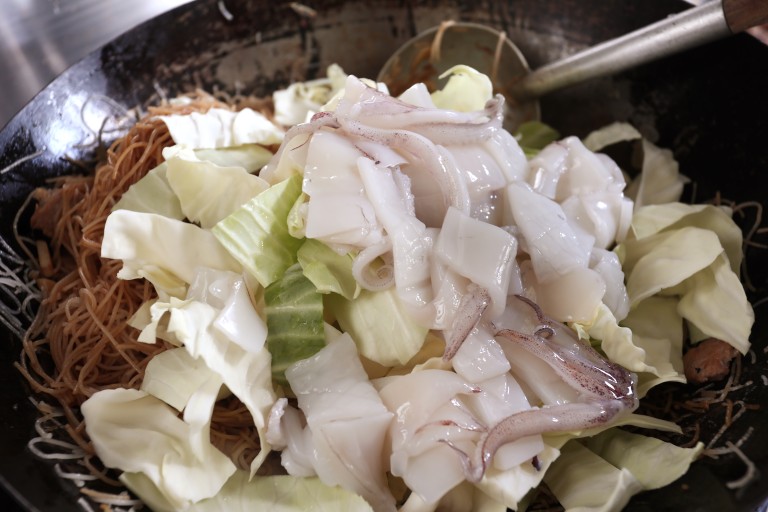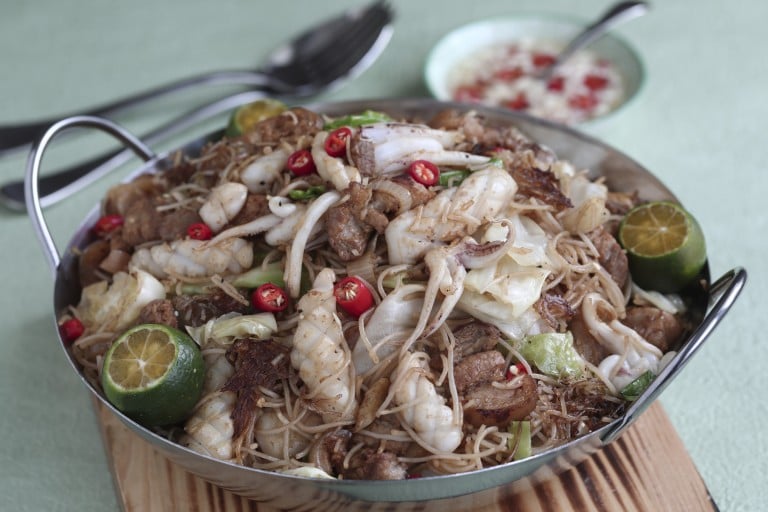
As with many Philippine dishes, pancit has its roots in another culture, in this case, China. But these stir-fried noodles – so far, so ordinary – are given a distinctive Philippine flavour with the addition of sour ingredients, which are used liberally in the Southeast Asian nation’s cuisine, and which brighten the taste of the dish, making it seem less heavy.
Many of these sour ingredients, such as kamias/bilimbi, are difficult to source outside the Philippines, so for this recipe, I’ve used easy-to-find alternatives – calamansi and white vinegar.
There are many variations of pancit. Some use different types of noodles, and you can make all-seafood versions, all-meat versions, or skip the protein entirely and use only vegetables. Depending on what you have in your fridge and pantry, you can also top the pancit with sliced hard-boiled egg, roughly crushed fried pork rinds, and/or a scattering of fried garlic or minced spring onion.
When you’re cleaning the squid, you might find intact ink sacs in the cavity (usually, the ink is ejected when the squid is being caught). The ink can be added to the pancit at the same time the soy sauce is mixed in. The ink will turn the noodles grey – the shade depends on how much ink you have – but it enhances the seafood flavour.
Put the rice noodles in a large bowl and add plenty of hot water to cover them. Leave to soak until pliable, then drain.
Prepare the squid. From the body, pull out the tentacles, quill and innards. Set aside any intact ink sacs, then discard the innards and quill. Cut off and discard the eyes and beak from the tentacles. Remove the purplish membrane from the body – it will pull off easily. Slit open the bodies and scrape away any remaining innards still attached to the flesh. Score the flesh in a small crosshatch pattern, then cut the body into bite-size strips. Put the pieces in the colander with the tentacles, rinse briefly then drain. Squeeze the ink from the sacs and put it in a small bowl (you should wear kitchen gloves when doing this, so the ink doesn’t stain your hands).
Slice the pork belly as thin as possible, then cut it into bite-sized pieces (it’s easiest to slice if you place it skin side-down on the cutting board). Cut the cabbage into long strips about 1cm (7/16in) wide. Halve the onion, then slice it thinly. Roughly chop the garlic and thinly slice the chillies.
Pour the soy sauce into a bowl. If you’re using the squid ink, mix it with the soy sauce and about 15ml of hot water. If you’re not using squid ink, mix the soy sauce with about 30ml of hot water.
Heat a large wok over a high flame. When the wok is hot, add 20ml (4tbsp) of oil. Add the pork, onion, garlic and chilli. Sprinkle with a little salt, stir-fry for about five minutes, then add the cabbage. Cook for a minute or two, or until the cabbage starts to wilt, stirring often.

Add the noodles and mix well. Drizzle in the soy sauce/squid ink or soy sauce/water and mix very well so the ingredients are evenly flavoured. Turn the heat to low, cover the wok with the lid and cook for a few minutes, mixing occasionally, until the noodles are tender. If the noodles are too firm, add a little hot water, cover with the lid and continue to cook until they’re done. Add the squid then stir well – the heat of the noodles will cook the pieces.
Remove the lid, turn the heat to high and briefly stir-fry the ingredients. Taste the noodles to see if they have enough seasoning; if necessary, sprinkle in some salt and mix well. The noodles should be moist, but without any excess liquid.
While the noodles are cooking, pour the white vinegar into a bowl, chop the garlic and the bird’s-eye chillies, then combine the ingredients.

Transfer the pancit to a serving dish. Serve immediately, with the calamansi and the bowl of vinegar/garlic/chilli, so diners can season their portions to their taste.